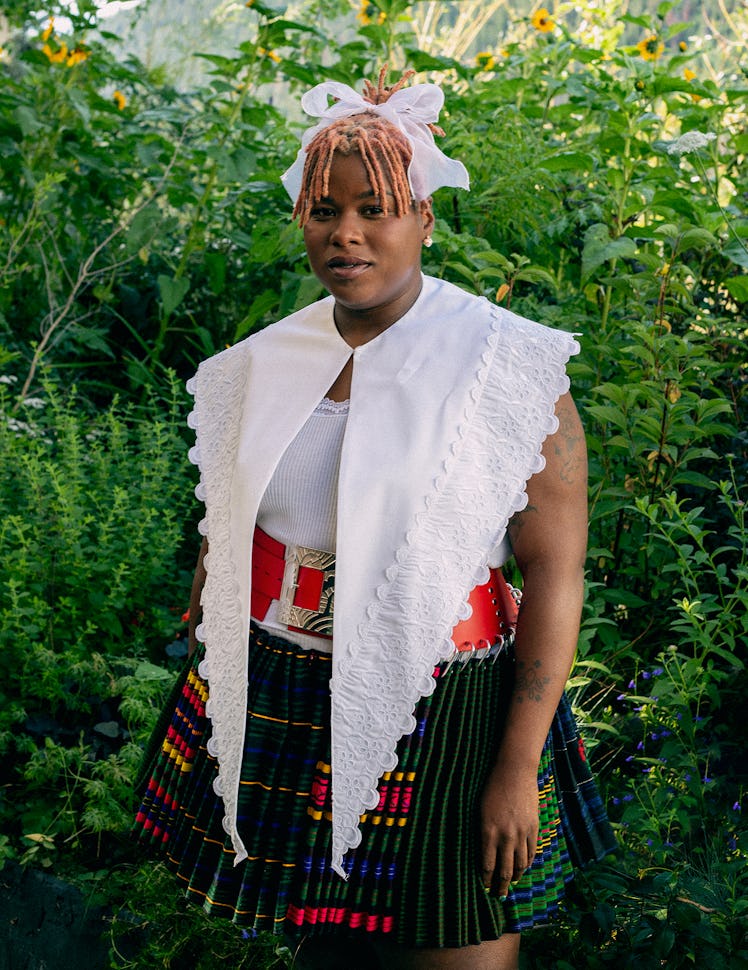For Precious Okoyomon, Joy Is Power
The artist, known for their living installations, reflects on what fuels the creative process.

For W’s annual The Originals portfolio, we asked creatives—pioneers in the fields of art, design, fashion, comedy, activism, and more—to share their insights on staying true to themselves. See this year’s full class of creatives here.
You’re a multidisciplinary artist who has created living installations out of plants, published books of poetry, and, as part of the collective Spiral Theory Test Kitchen, created surrealist feasts that include fish bones and ball gags made of frozen cucumber juice. What have you been working on lately?
Constructing my garden at the Aspen Art Museum, titled “Every Earthly Morning the Sky’s Light touches Ur Life is Unprecedented in its Beauty,” was an 18-month process. I made my first stoneware sculpture for the installation—a three-foot-tall deity—and since then I’ve gotten more into ceramics, wood firing, and natural clay. I also have some shows in Austria, Switzerland, and Rome later this year and next year too. But overall, I’m just doing a lot of research. Research and playing.
What does playing entail?
Play is study. My practice is based on dreaming and envisioning new worlds. A lot of my work stems from the exuberant miracle of the everyday. It’s about an ontology of the mystical, about how we think past the human. The human can only reproduce what has come before it, and I have no interest in that. We have boxed ourselves in and created a separation from a beautiful world that is constantly trying to reach out and connect with us, which is why we have a lot of the societal issues we have today. We don’t know how to communicate with the world around us. And this is why I feel it is urgent that we start dreaming radically.
What media are you prioritizing right now?
I’m constantly writing poems. They are my prayers. I’m falling in love with ceramics; I think they are in the future. I want to make playgrounds—I’m thinking about how to fall gracefully. Always the soil. Always planting. Soil and plants are big in my work.
What do you feel living matter can communicate that inanimate objects cannot?
It’s about the power of not being able to control. Materials that I don’t have control over can hold the miracle of surprise.
Your Aspen Art Museum installation [pictured above and below] was so comprehensive—a whole ecosystem of living matter, with colors, creatures, and sound at play with one another. What went into creating that?
I started off researching and reading. Saidiya Hartman’s essay “Venus in Two Acts” was a reference. I was considering who has access to pleasure and luxury and also thinking of the abundance of a garden. The title is inspired by Simone White [who did a poetry reading in the space for the 2022 summer solstice]. A lot of really weird experimenting went into the garden.
What happened after the installation closed?
Everything went back into the community that nourished the work for 18 months: The trees went to community centers, local schools, and education centers. The soil is getting repurposed.
It seems like you have a consciously organic vision for your work’s afterlife. Do some of your installations flow into future work?
The kudzu ash from my Performance Space New York installation last year, “Fragmented Body Perceptions as Higher Vibration Frequencies to God,” reappeared in my installation at the Venice Biennale, “To See the Earth Before the End of the World.” And the Performance Space piece incorporated ash from the incinerated kudzu vines that grew inside of my piece Earthseed, at the Museum für Moderne Kunst. It’s a life cycle; everything bleeds into another work. I don’t see much of my work as having an end.
Your Venice Biennale piece was also an ecosystem of sorts. You filled a room in the Arsenale with soil, plants, bubbling streams, butterflies, and sculpted figures.
I named it after one of my favorite poems by Ed Roberson. It’s one of the biggest installations I’ve ever made, based on the Édouard Glissant play Monsieur Toussaint and the Haitian revolution. It incorporates sugarcane and kudzu. Sugarcane is something that’s been ever present in my family background. It was always a treat in my house, and my grandmother grew it in our backyard. I was also thinking about environmental racism and the historical energy the plants hold. I wanted to create a space for these invasive monstrosities to take over and have their moment.
Do you think about the apocalypse when making? Does destruction have solely negative connotations for you?
When am I not thinking about the apocalypse? The world ends for somebody every day, usually someone Brown or Black. But I’m past acknowledging the end is coming. The end is here, and it’s been here. We need a new world. We need new forms of language and communication. We need to actually touch each other. Take me past the primordial fear! Take me past the suffering! I want miracles, oracles, and love!
What is your ideal vision of the future?
Just enjoyment. I’m forever learning and falling and picking myself up. I’m dangerously fearless and optimistic. In the body I’m in, I think it’s radical to not be fearful, because we live in a world that wants us to be afraid. There is so much power in being joyous.
Hair and makeup by Josefina Low at GR Hair & Makeup.